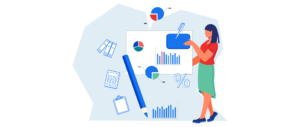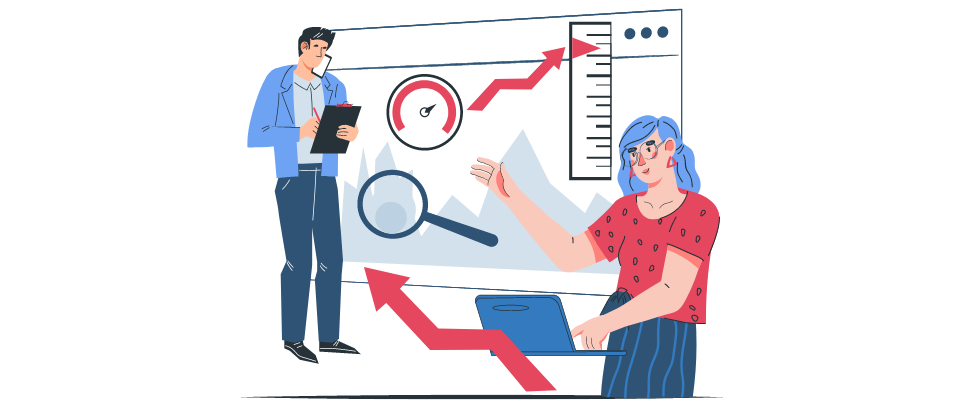Are you ready to unlock the power of data?
Imagine having the ability to decipher trends, predict customer behaviors, and make informed decisions that drive your business to new heights.
If the world of business analytics seems like an enigma wrapped in a riddle to you, fear not!
Everything You Need to Know about Business Analytics!
In this blog, we’re diving deep into the dynamic realm of business analytics, demystifying its core concepts, benefits, tools, and career opportunities.
So, fasten your seatbelts as we embark on this exciting journey to unravel the mysteries of data-driven success!
What Exactly is Business Analytics?
Before we dive into the technicalities, let’s answer the big question: What is business analytics?
Imagine you have a treasure trove of data collected from your business operations. Business analytics is the art of transforming this data into actionable insights.
It’s like having a crystal ball that helps you understand past trends, current performance, and future possibilities, guiding your decision-making process.
Why Should You Care About Business Analytics?
Hold on, why should you care about business analytics?
Well, imagine you’re steering a ship across the vast ocean of business. Without a compass, you’re at the mercy of the waves.
Business analytics is that compass – it gives you a clear sense of direction, helping you navigate towards success. Whether you’re a small startup or a global enterprise, data-driven insights can be the wind beneath your sails.
Peeling Back the Layers: Types of Business Analytics
Imagine business analytics as a versatile toolbox, each tool designed for a specific task. Just as you wouldn’t use a hammer to tighten a screw, different types of business analytics serve distinct purposes.
Let’s take a closer look at these powerful analytical approaches:
1. Descriptive Analytics: The Storyteller
Descriptive analytics is like the historian of your business data. It delves into historical records to paint a vivid picture of past events. Remember flipping through old photo albums?
Descriptive analytics lets you flip through the pages of your business’s diary, reliving its journey. It’s about understanding what has already transpired, whether it’s sales figures, website visits, or customer interactions.
Imagine you’re running an e-commerce store, and you want to know how your sales performed over the last year. Descriptive analytics helps you summarize the sales trends, identifying the best-selling products, peak sales periods, and customer preferences. By understanding the past, you gain insights to inform your future decisions.
2. Diagnostic Analytics: The Detective

If descriptive analytics is the historian, then diagnostic analytics is the detective. It goes beyond simply recounting events and delves into the realm of understanding why things happened the way they did.
Just as Sherlock Holmes uncovers the mysteries behind crimes, diagnostic analytics investigates the mysteries within your business data.
Consider a scenario where your online customer engagement suddenly dropped last month. Diagnostic analytics would be your trusty investigator, digging deep to find out why.
It might uncover that a recent website redesign led to a less user-friendly experience, causing customers to bounce away.
By identifying the root causes, diagnostic analytics empowers you to take corrective actions and prevent similar issues in the future.
3. Predictive Analytics: The Fortune Teller

Predictive analytics brings a touch of magic to the business world. Like a fortune teller with a crystal ball, it uses historical data to predict future outcomes. But this isn’t mere crystal ball gazing – it’s data-driven insights that help you anticipate trends and events before they occur.
Imagine you’re a retailer gearing up for the holiday season. Predictive analytics can analyze past holiday shopping patterns, customer behaviors, and market trends to forecast this year’s demand for specific products.
Armed with these predictions, you can optimize inventory levels, marketing strategies, and staffing, ensuring that you’re prepared for the holiday shopping rush.
4. Prescriptive Analytics: The Strategist

Prescriptive analytics takes your data insights to the next level. It’s like having a strategic advisor by your side, not only predicting future scenarios but also recommending the best course of action to achieve desired outcomes.
If predictive analytics tells you what’s likely to happen, prescriptive analytics tells you what you should do about it.
Imagine you’re managing a call center and want to reduce customer wait times. Prescriptive analytics could analyze call data, agent availability, and historical response times to suggest optimal staffing levels for different time slots.
It might even recommend real-time adjustments based on incoming call patterns. By following these recommendations, you can enhance customer satisfaction while efficiently utilizing resources.
In a nutshell, business analytics isn’t just about crunching numbers – it’s about unlocking insights that drive informed decisions.
Whether you’re unraveling the story of the past, solving mysteries, foreseeing the future, or strategizing for success, these types of business analytics offer a comprehensive toolkit for harnessing the power of data.
Tools of the Trade: Business Analytics Software
Now that we’ve peeled back the layers of business analytics, it’s time to dive into the essential tools that turn data into gold.
Just as a craftsman relies on their tools to shape masterpieces, a business analyst depends on specialized software to transform raw data into valuable insights.
Let’s explore these tools that are at the heart of the business analytics process:
1. Tableau: The Visual Storyteller
Tableau is like a painter’s palette, allowing analysts to create vivid visualizations from data. It empowers you to craft interactive dashboards, graphs, and charts that bring data to life. Imagine translating complex datasets into easy-to-understand visuals, helping decision-makers grasp insights at a glance.
For instance, a retail company using Tableau can visualize sales data across regions, product categories, and time periods. These interactive visuals enable spotting trends, identifying best-performing products, and optimizing inventory strategies.
With Tableau, you’re not just crunching numbers; you’re painting a data-driven picture that guides strategic decisions.
2. Power BI: The Data Illuminator
Power BI, Microsoft’s offering, shines a spotlight on your data, illuminating patterns and trends. It’s like having a powerful torch to navigate through the data labyrinth. With drag-and-drop simplicity, you can connect to various data sources, create insightful reports, and share them seamlessly.
Imagine you’re in charge of a marketing campaign. Power BI can merge data from different platforms, such as social media, website analytics, and email campaigns.
By analyzing this integrated data, you can gauge the campaign’s effectiveness, identify high-performing channels, and allocate resources smartly. Power BI turns raw data into a beacon of clarity.
3. Python: The Swiss Army Knife
Python is a versatile tool in your business analytics toolkit. It’s like a Swiss Army knife equipped with diverse functionalities. From data manipulation and cleaning to advanced statistical analysis and machine learning, Python can handle it all. Its extensive libraries make complex tasks surprisingly accessible.
Consider a scenario where a healthcare provider wants to predict patient readmission rates. Python’s machine learning libraries can help create predictive models based on patient history, demographics, and medical conditions.
By leveraging Python’s capabilities, you can enhance patient care by identifying high-risk cases and implementing preventive measures.
4. R: The Statistical Maestro
R is the conductor of the statistical orchestra, harmonizing data analysis and visualization. It’s tailor-made for statisticians and data scientists, providing an array of tools for in-depth analysis. R’s powerful statistical packages enable you to uncover insights that might go unnoticed with other tools.
Imagine you’re working for a financial institution aiming to detect fraudulent transactions. R can help build intricate anomaly detection algorithms by analyzing transaction patterns, identifying outliers, and flagging potential fraud.
With R’s analytical prowess, you can safeguard financial transactions and maintain the integrity of the system.
Business Analytics in Action: Real-World Marvels
Now, let’s step into the real world, where business analytics transform industries. Retailers use predictive analytics to anticipate shopping trends, ensuring their shelves are stocked with the right products.
Healthcare providers optimize patient care by analyzing medical histories and treatment outcomes, enhancing patient well-being. Banks harness the power of analytics to swiftly detect fraudulent transactions, safeguarding both customers and institutions.
From supply chain optimization that maximizes efficiency to customer relationship management that fosters loyalty, business analytics is a force that propels businesses forward. It’s the magic wand that turns data into insights, enabling strategic decisions that shape the future.
Ready to wield these transformative tools and embark on a journey of data-driven discovery?
Join Accredian’s Business Analytics and Data Science course to gain hands-on experience with Tableau, Power BI, Python, and R, and unlock the potential to revolutionize businesses through data insights.







